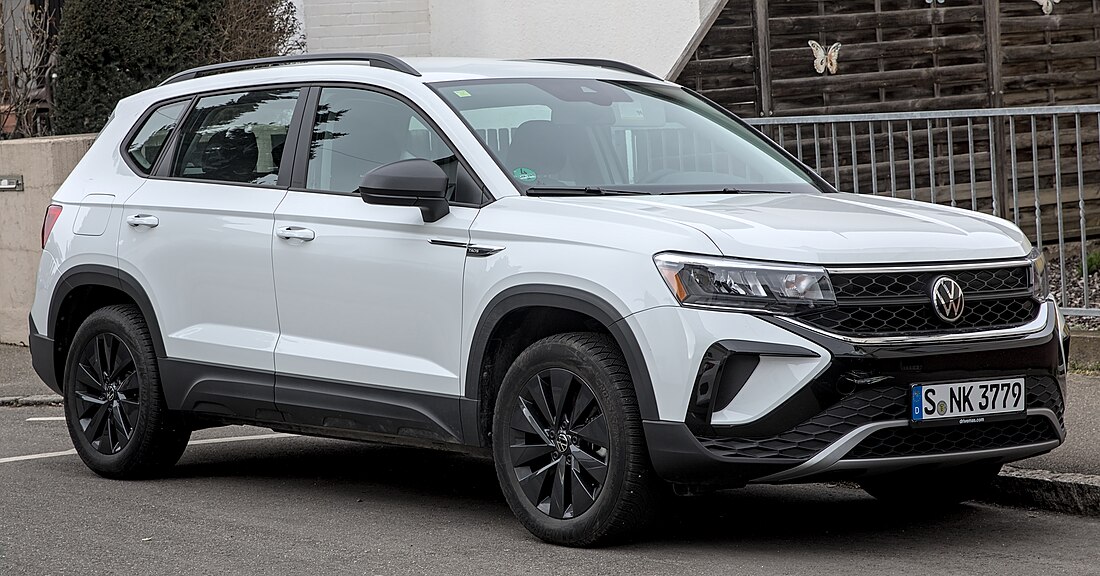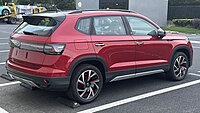Volkswagen Taos
Motor vehicle From Wikipedia, the free encyclopedia
The Volkswagen Taos is a compact crossover SUV manufactured and marketed by Volkswagen. It was first released in October 2018 as the Volkswagen Tharu in China, while the Taos was released in October 2020 as a restyled version of the Tharu for the North American, South American, and Russian markets. In the brand's lineup, the vehicle is positioned below the Tiguan, and in South America and China above the T-Cross.[9] It is not marketed in core European market.
| Volkswagen Taos/Tharu | |
|---|---|
 | |
| Overview | |
| Manufacturer | Volkswagen |
| Also called | Volkswagen Tharu |
| Production |
|
| Model years | 2022–present |
| Assembly |
|
| Designer | Klaus Bischoff and Johannes Brandsch (Tharu)[8] |
| Body and chassis | |
| Class | Compact crossover SUV (C) |
| Body style | 5-door SUV |
| Layout | Front-engine, front-wheel-drive Front-engine, all-wheel-drive |
| Platform | Volkswagen Group MQB A1 |
| Related | SEAT Ateca Škoda Karoq Jetta VS5 |
| Powertrain | |
| Engine | |
| Transmission | 5-speed manual 6-speed manual 6-speed automatic 8-speed automatic 7-speed DSG |
| Battery | 44.1 kWh (e-Tharu) |
| Electric range | 315–415 km (195.7–257.9 mi) (e-Tharu, NEDC) |
| Dimensions | |
| Wheelbase | 2,690 mm (105.9 in) 2,680 mm (105.5 in) (China) 2,638 mm (103.9 in) (Russia) |
| Length | 4,465 mm (175.8 in) 4,453 mm (175.3 in) (China) 4,417 mm (173.9 in) (Russia) |
| Width | 1,841 mm (72.5 in) |
| Height | 1,602–1,635 mm (63.1–64.4 in) |
The Taos is named after Taos, New Mexico.[10][11] The Tharu name is derived after the eponymous Tharu people, an ethnic group indigenous to Nepal and Northern India.[12]
Overview
The Taos/Tharu is based on the Volkswagen Group MQB A1, with its platform closely related and several sheet metals shared with the SEAT Ateca, Škoda Karoq and the Jetta VS5.[9] Known as the 'Project Tarek' during development, the Taos/Tharu is considered the first Chinese-developed VW product that is sold outside China. Volkswagen's brand sales chief Jürgen Stackmann said the project "turned from a regional project into a global project." Global annual sales for the vehicle were projected at 400,000 units.[13]
- Rear view
Markets
Summarize
Perspective
North America
The Taos debuted for the North American market on 13 October 2020 for the 2022 model year. It is the fifth addition to the Volkswagen SUV family in the last four years.[14] The Mexican-built Taos slots directly below the Tiguan, which is solely available in a long-wheelbase guise in the North American market, while acting as an indirect replacement for the discontinued Golf.[15]
The Taos for the US and Canadian market is powered by a 1.5-liter, four-cylinder turbocharged gasoline engine known as the TSI Evo, borrowed from VW's European models. The engine packs 158 hp (160 PS; 118 kW) and 184 lb⋅ft (249 N⋅m; 25 kg⋅m) at 1,750 rpm. Front-wheel-drive models feature an 8-speed automatic transmission, while the 4Motion all-wheel drive is coupled with a 7-speed DSG transmission.
Volkswagen's Digital Cockpit system is standard on all trims, replacing the physical instrument cluster dials with a reconfigurable 12.3-inch display. The Taos can function as a Wi-Fi hotspot and is available with a wireless charge pad. All but the base model feature an 8.0-inch touchscreen and the latest MIB3 infotainment software. Volkswagen sells the Taos in S, SE, and SEL trims.
The Taos for the Mexican market is powered by a 1.4-liter, four-cylinder turbocharged gasoline engine from the Volkswagen EA211 TSI engine family, paired with a 6-speed automatic transmission. The 1.4 TSI engine produces 150 PS (148 hp; 110 kW) and 25.5 kg⋅m (250 N⋅m; 184 lb⋅ft) of torque.[16] In Mexico, the Taos is available in Trendline, Comfortline, and Highline trims. All trims are only available in FWD drivetrain configuration.[17]
South America
Introduced on 13 October 2020, the vehicle is also sold as the Taos with an identical styling to the North American Taos. For this market, the vehicle is produced in General Pacheco plant in Argentina.[18][19] It occupies a segment between the T-Cross and Tiguan. It is the first C-segment SUV made in Argentina.[20] Instead of the TSI Evo engine, the Argentinian-built Taos is powered by a 1.4-liter 4-cylinder TSI gasoline engine producing 150 hp (152 PS; 112 kW) and 25.5 kg⋅m (250 N⋅m; 184 lb⋅ft) which is sourced from the São Carlos engine plant in Brazil and supports flex fuel. The engine is coupled with a 6-speed automatic transmission.[21]
As of 2022, the Argentine version contains 20% locally-made parts.[22] 70% of its production is exported.[23]
Russia
The Russian-market Taos was announced on 4 March 2021. It is assembled in Nizhny Novgorod by GAZ alongside the similar Škoda Karoq. As the result, the Taos for the Russian market uses an identical rear quarter panel and chassis from the Karoq, making it shorter in length and wheelbase compared to the Americas-market Taos and the Chinese-market Tharu, and requiring a different tailgate panel, rear taillights and rear bumper to be installed.
Engine options available are 1.6-litre MPI producing 110 hp (112 PS; 82 kW) and 1.4-litre TSI producing 150 hp (152 PS; 112 kW). The base engine comes with a 5-speed manual or 6-speed automatic transmission and front-wheel drive, while the TSI is mated to either an 8-speed automatic for the FWD version or a 7-speed DSG transmission with 4Motion AWD. The range will include Respect, Status and Exclusive trim levels.[24][25]
Powertrain
| Petrol engines | |||||
|---|---|---|---|---|---|
| Model | Displacement | Power | Torque | Transmission | Markets |
| 1.4 TSI 150 | 1,395 cc I4 | 150 PS (110 kW; 148 hp) | 250 N⋅m (184 lb⋅ft) | 6-speed automatic | Latin America |
| 8-speed automatic or 7-speed DSG | Russia | ||||
| 1.5 TSI 160 | 1,498 cc I4 | 160 PS (118 kW; 158 hp) | 250 N⋅m (184 lb⋅ft) | 8-speed automatic or 7-speed DSG | United States and Canada |
| 1.6 MPI 110 | 1,598 cc I4 | 110 PS (81 kW; 108 hp) | 155 N⋅m (114 lb⋅ft) | 5-speed manual or 6-speed automatic | Russia |
China (Tharu)
The Tharu was presented as a near production model called the 'Powerful Family SUV' in March 2018.[26] Built by SAIC Volkswagen, the vehicle became available in China in late October 2018.[27][28] The vehicle was assembled in three locations, including in Xinjiang Uygur Autonomous Region in the city of Ürümqi.
It is offered with several powertrain options, including one electric version called the e-Tharu. The base model of the Tharu has a torsion axis, the higher versions have a multi link suspension.[29]
Volkswagen cooperated with the headphone manufacturer Beats Electronics to incorporate the Beats audio system in the vehicle.[27]
The Chinese-built Tharu was launched in the Philippine market on September 29, 2023. It is available in both the SE and SEL trim levels.[30][31]
- 2020 Volkswagen Tharu (China)
- 2020 Volkswagen Tharu (China)
- 2023 Volkswagen Tharu facelift (China)
- 2023 Volkswagen Tharu facelift (China)
Powertrain
| Petrol engines | |||||
|---|---|---|---|---|---|
| Model | Series | Displacement | Power | Torque | Transmission |
| 1.2 TSI | 1,197 cc I4 | 118 PS (87 kW; 116 hp) | 200 N⋅m (148 lb⋅ft) | 6-speed manual or 7-speed DSG | |
| 1.4 TSI '280 TSI' | EA211 | 1,395 cc I4 | 150 PS (110 kW; 148 hp) | 250 N⋅m (184 lb⋅ft) | 6-speed manual or 7-speed DSG |
| 2.0 TSI '330 TSI' 4Motion | EA888 | 1,984 cc I4 | 190 PS (140 kW; 187 hp) | 320 N⋅m (236 lb⋅ft) | 7-speed DSG |
e-Tharu
The electric version of the Tharu was released in November 2020. It is equipped with an electric motor that produces 136 PS (100 kW; 134 hp) and 290 N⋅m (214 lb⋅ft) of torque. The vehicle is powered by a 44.1-kWh battery pack rated at 315 km (196 mi) of range (NEDC). Driven at a constant speed of 60 km/h (37 mph), the e-Tharu is claimed to be able to travel 415 km (258 mi) between charges.[32][33]
Safety
The Taos has ventilated front disc brakes and solid rear ones.[34][35]
Latin NCAP
The Latin American Taos with 6 airbags, airbag switch, UN127 pedestrian safety standard, ESC, ISA, full SBR, and optional collision avoidance system received 5 stars from Latin NCAP in 2021 under its new protocol (similar to Euro NCAP 2014).[36]
IIHS
The 2022 Taos was tested by the IIHS:[37]
| Small overlap front (Driver) | Good | |||
| Small overlap front (Passenger) | Acceptable | |||
| Moderate overlap front | Good | |||
| Side | Good | |||
| Roof strength | Good | |||
| Head restraints and seats | Acceptable | |||
| Headlights |
|
varies by trim/option | ||
| Front crash prevention (Vehicle-to-Vehicle) | Superior | optional | ||
| Front crash prevention (Vehicle-to-Pedestrian, day) | Basic | optional | ||
| Child seat anchors (LATCH) ease of use | Good | |||
Sales
References
External links
Wikiwand - on
Seamless Wikipedia browsing. On steroids.





